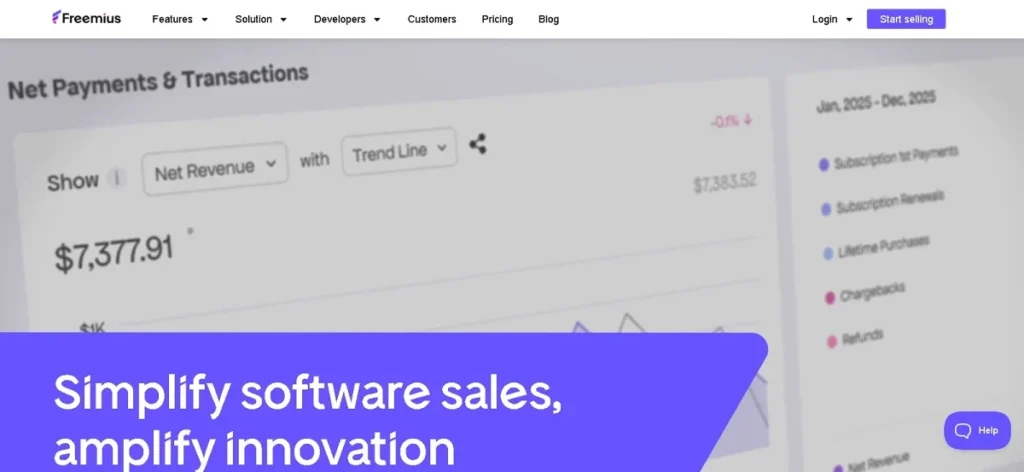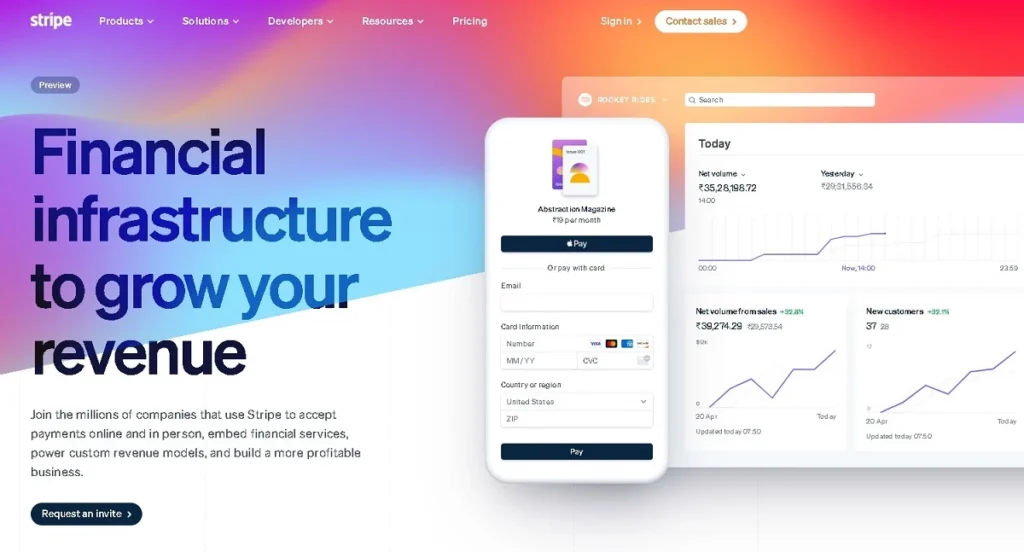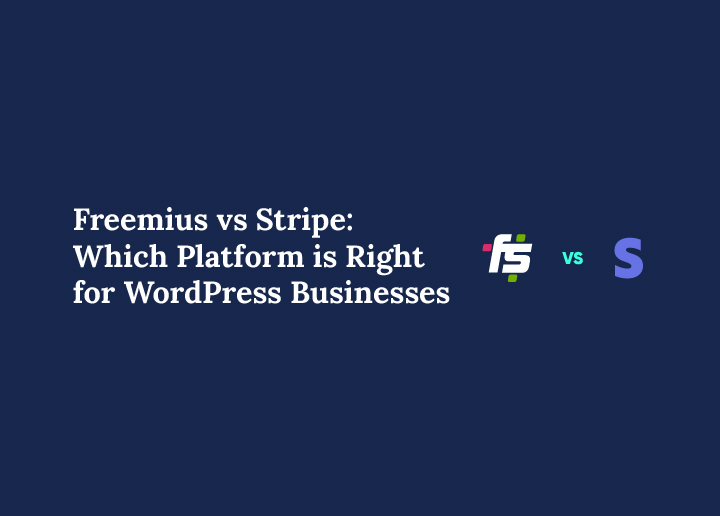When it comes to selling digital products, plugins, or running a micro SaaS, choosing the right payment platform is critical. Freemius vs Stripe is a common comparison among software makers looking for the best way to handle payments, chargebacks, and global tax compliance.
Stripe offers powerful tools but comes with extra fees, a complex dispute process, and the new Stripe chargeback fee. Freemius, on the other hand, takes a different approach, it handles disputes, manages tax compliance, and helps eliminate chargeback headaches for you.
This article breaks down both platforms so you can confidently choose the one that fits your business model and protects your bottom line.
Understanding Freemius vs Stripe
When comparing Freemius vs Stripe, it’s important to understand that these platforms are built for very different types of users and use cases, even though they both support online payments. Let’s take a closer look at what each one offers, and who they’re best suited for.
What is Freemius?
Freemius is an all-in-one monetization, licensing, and analytics platform designed specifically for WordPress developers, plugin and theme creators, and micro SaaS businesses. Unlike generic payment gateways, Freemius focuses on everything a software maker needs to manage the entire product lifecycle, from checkout to subscription management to software licensing.

With Freemius, you get a built-in checkout that can be embedded directly into your site or product, eliminating the need to create a separate storefront. It also includes tools for managing recurring subscriptions, one-time purchases, and free trials, which are ideal for growing SaaS businesses or selling multiple tiers of digital products.
One of the standout features is EU VAT handling, which means Freemius automatically calculates, collects, and remits taxes for customers in the EU, removing a huge compliance burden. You also gain access to user analytics, churn insights, email automation, and more, helping you make smarter product and marketing decisions.
What sets Freemius apart in the Freemius vs Stripe debate is that it handles disputes internally. Freemius handles disputes on your behalf, using collected user data to fight chargebacks and reduce the risk of lost revenue, something especially useful for developers who don’t want to get involved in the dispute process. This approach ensures you’re not constantly stuck verifying payment details or worrying about chargeback fees.
What is Stripe?
Stripe is a global payment processor known for its powerful APIs, flexibility, and ability to scale with businesses of all sizes. It’s widely used by developers, marketplaces, SaaS platforms, and eCommerce stores looking to build custom payment flows.

Stripe allows businesses to accept credit and debit cards, digital wallets (like Apple Pay and Google Pay), and a variety of local payment methods across different regions. It’s particularly strong in developer-friendliness, its customizable APIs let you build just about any payment or subscription system imaginable, making it a favorite for teams with in-house development resources.
Key features of Stripe include recurring billing, invoicing, and detailed financial reporting. It also supports one-time purchases, metered billing, and multiple currencies. However, Stripe puts the responsibility of handling chargebacks and global tax compliance on the merchant. That means if a dispute arises, you’ll need to manage the entire dispute process, gathering records, responding within deadlines, and potentially paying a Stripe chargeback fee, which can now go up to $15 per dispute under the new Stripe chargeback fee structure.
This makes Stripe extremely powerful, but also potentially high-risk if you’re a solo developer or small team trying to avoid dealing with complex chargebacks, tax rules, or extra fees that eat into profits.
Discover: Best WooCommerce Payment Gateways
Need Help Integrating Freemius or Stripe into Your WordPress Site?
Seahawk Media offers expert WordPress development services to set up secure, high-converting payment solutions tailored to your business.
Freemius vs Stripe: Key Differences
When choosing between Freemius vs Stripe, it helps to break down their core differences in areas like setup, features, payouts, and fee structures. Each platform is built with a specific user in mind. Freemius focuses on plugin and software developers, while Stripe offers a flexible payment infrastructure for virtually any type of online business. Here’s a deeper look at how they compare:

Ease of Setup
Freemius is truly plug-and-play, especially for WordPress developers. You simply install their SDK into your plugin or theme, and you’re ready to start accepting payments, managing licenses, and delivering updates. It’s designed so that even non-technical creators can launch and sell products without building out an entire eCommerce system.
Stripe, on the other hand, is more technical by nature. While platforms like WooCommerce or Easy Digital Downloads offer integrations with Stripe, using Stripe alone often requires custom development, especially if you want to build advanced features like subscription billing, dunning management, or invoicing workflows. For software makers without a dev team, this can mean added time, cost, and complexity.
Features and Focus
Freemius is tightly focused on the needs of developers selling WordPress plugins, themes, and micro SaaS tools. It offers features like built-in software licensing, an embeddable user dashboard, customer analytics, opt-ins, and update delivery. Everything is packaged specifically for the WordPress ecosystem, making it highly streamlined for its niche.
Stripe is more general-purpose. It supports everything from physical product sales to marketplaces to large SaaS billing flows. While this makes it incredibly flexible, it lacks Freemius’ targeted features like licensing, plugin insights, or usage-based dashboards that are essential for WordPress-focused developers.
Developer Friendliness
Stripe is one of the most developer-friendly platforms out there. Its API-first design gives you complete freedom to create custom checkout flows, manage subscriptions, offer discounts, and even build complex multi-user billing systems. This level of flexibility is great for large teams or custom SaaS apps.
Freemius, in contrast, offers limited customization. It’s meant to “just work” out of the box for WordPress plugin and theme developers. While you don’t get the same depth of flexibility, what you do get is a highly optimized toolset built specifically for your product type. This approach ensures that developers don’t waste time reinventing the wheel, ideal for solo creators or small teams.
Revenue Handling
One of the biggest differences in the Freemius vs Stripe debate is how each handles revenue and tax compliance. Freemius acts as the merchant of record, which means it is the legal seller and handles global tax compliance, including EU VAT and regional digital tax laws. This is a huge benefit if you sell globally and want to avoid dealing with the complexity of managing taxes in dozens of jurisdictions.
With Stripe, you are the merchant of record. That means you’re responsible for calculating and collecting taxes, filing reports, and complying with local regulations. This gives you full control, but also full responsibility, making it more work for those without accounting or tax tools in place.
Payouts
Freemius pays out once a month via PayPal or wire transfer, depending on your preferences and region. While this schedule may be limiting for some, it simplifies accounting by providing predictable monthly revenue statements.
Stripe offers faster payouts, often on a daily or weekly basis, directly to your connected bank account. This is especially useful for businesses with higher cash flow needs or who want real-time access to revenue. However, depending on the country and account type, payout times may vary.
Pricing and Fees
Freemius operates on a revenue-share model, taking a percentage of each sale (starting at 27% and decreasing as you earn more). This includes everything, payment processing, tax handling, dispute resolution, and infrastructure. While this may seem steep, it bundles many services that would otherwise cost extra if you managed them yourself.
Stripe, in contrast, charges a flat transaction fee, typically 2.9% + 30¢ per transaction for domestic cards. However, there are extra fees for international cards, currency conversion, subscriptions, and tools like Radar (fraud detection). You also face dispute fees (up to $15 per case) when handling chargebacks, and the platform requires you to manage these manually.
Also Know: How to Setup and Start an Ecommerce Store
Who Should Use Freemius?
Freemius is the go-to solution for WordPress plugin and theme developers who want to focus on building great products without getting bogged down in the technical and legal complexities of selling them. It’s especially well-suited for solo developers or small teams who don’t have the resources to handle tasks like building checkout flows, managing global tax compliance, or fighting chargebacks. With Freemius, you get licensing, payments, subscriptions, EU VAT handling, and customer analytics in one centralized platform, with no additional integrations needed.
This makes Freemius a smart choice if you’re launching a new product and want to start earning revenue fast. You can embed a checkout inside your plugin or site, automate license key generation, track active installations, and send email notifications without writing a single line of server-side code. Since Freemius handles disputes and acts as the merchant of record, you also avoid having to deal with chargeback fees, tax filing, or Stripe disputes.
If you’re tired of piecing together tools to manage subscriptions, licensing, refunds, and user dashboards, and want an all-in-one solution built specifically for WordPress products, Freemius is a great match. It’s a plug-and-play platform that lets you stay focused on your plugin or theme while it takes care of the rest, including handling chargebacks, tracking user data, and providing exceptional support along the way.
Who Should Use Stripe?
Stripe is ideal for SaaS companies, digital agencies, and businesses with developer resources that want to build a fully customized, scalable payment solution. If you need complete control over the checkout experience, such as customizing user flows, setting dynamic pricing, building marketplace features, or integrating with a unique product model, Stripe provides the tools to make it happen.
Stripe is also a top choice for businesses operating at a larger scale or across multiple regions. It supports multiple currencies, payment methods, recurring billing, and advanced tools like fraud protection, invoicing, and financial reporting. That said, with this power comes responsibility.
For teams with technical talent or those who already have infrastructure in place to handle payments, taxes, and customer support, Stripe offers unmatched flexibility. It’s perfect if your business is beyond selling a single WordPress plugin or if you offer multiple services or products across different channels.
In short, if you’re building a custom SaaS, scaling an agency, or expanding globally and want the ability to fine-tune every aspect of your payment stack, Stripe is the right fit.
Pros and Cons Recap: Freemius vs Stripe
When deciding between Freemius vs Stripe, it really comes down to what kind of business you’re running and how much control you want over your payment infrastructure. Below is a quick side-by-side comparison to help you visualize the trade-offs.
| Platform | Pros | Cons |
|---|---|---|
| Freemius | Super easy to set up, handles software licensing, built-in analytics, EU VAT and tax compliance included, Freemius handles disputes, ideal for WordPress plugins and themes | Higher fees (revenue share model), limited to WordPress ecosystem, less flexibility for custom use cases |
| Stripe | Total control over checkout flow, flexible APIs, fast payouts, supports global currencies and payment methods, ideal for SaaS and agencies | Requires developer integration, you’re responsible for tax collection and chargeback fees, and must handle disputes yourself |
Conclusion
At the end of the day, Freemius vs Stripe isn’t about which platform is objectively better; it’s about which one is a better fit for your business model. If you’re a WordPress plugin or theme developer who values simplicity, automation, and wants to skip the hassle of tax management, handling chargebacks, and building custom workflows, Freemius is likely the smarter choice. It lets you launch quickly, monetize efficiently, and grow without worrying about technical debt or compliance issues.
On the other hand, if you’re running a SaaS product, managing multiple product lines, or working with a development team, then Stripe offers unmatched flexibility and scalability. It’s ideal for businesses that need to tailor the checkout experience, integrate with existing systems, or support advanced eCommerce features.



